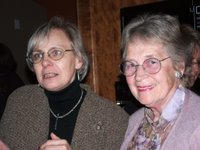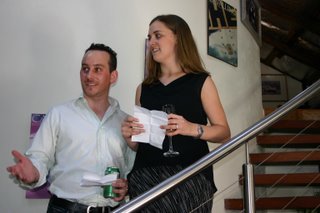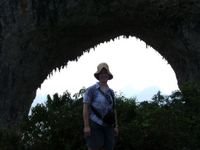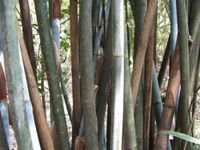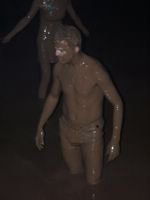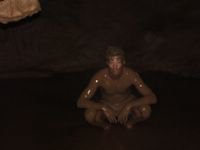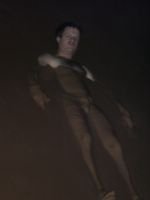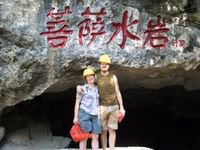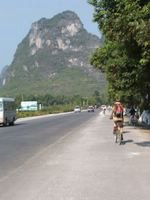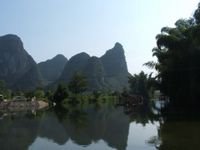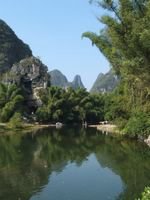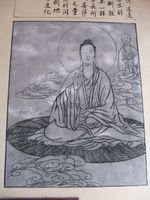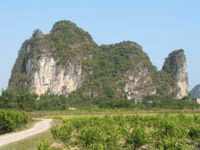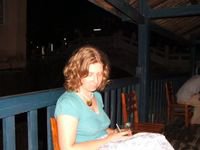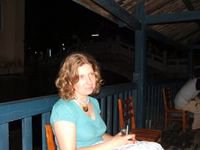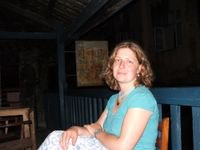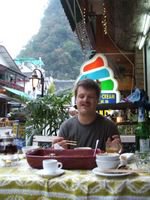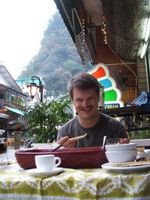Thursday, September 28, 2006
A few picks
We had a fabulous time at B&J's wedding on Saturday in Red Deer. Jenn's asked me not to post photos of her dress so I've just got a few warm up photos and photos of tom and i.
The wedding, at the Red Deer Museum, was beautiful and many cried during the ceremony, including Ben after he saw Jenn walking with her dad, Rand, down the aisle. Jenn laughed her way through it-- it was gorgeous to see.
The reception was at the Black Night Inn and we ate, drank and danced our way through until 2am.
Chris, Jenn's mum, had her house chockblock with Batagols, Rand and Karen out at the farm hosted Tom and I as well as Travis, Imran and Lisa and Paul. Jo stayed with Jenn's cousins Clark and Rachel and Elva with Chris's boss Nona. We had a great time staying with 'real' Red Deereans rather than in hotels.
Now We're in Boston staying with Saff and Brett and have been seeing lots of Simon and Maree and have met Tait for the first time. We're off to NYC tomorrow.
posted by Becky in Cambridge MA.
Friday, September 15, 2006
Sunday, November 27, 2005
Kite country
This chapter reports selected highlights from our four weeks of traveling through India. The photographs, mostly by Becky, will follow as soon as we can find a suitable internet connection to post them from, but for now we hope the text will give you a bit of a sense. Here we have seen many incredible things, and of course, but sadly, can share only snippets of them now. It would have been really nice to have you with us — but if you live in Melbourne we shall have you with us again soon enough. Becky has accepted a lectureship in Law at Monash, and we are returning to set up our lives there in early December.
Late on 24 October, Becky and I flew by Cathay Pacific to Delhi, arriving just after 05h00 the following morning. We had arranged a pickup car to take us to our hotel in Majnu-ka-tilla, the Tibetan quarter just north of Old Delhi. After a bit of sleep catchup, there was a lot lot lot to see and do, so we quickly got into the swing of catching autorickshaws.
I solemnly believe the autorickshaw (‘tuk-tuk’) is the most beautiful mode of motorised road transport to be found. For all travel under 60km/h, its versatility, fuel efficiency, and comfort make it an extremely competitive market performer. Coming in two and four-stroke varieties, it is a three-wheeler with a motorcycle front-end and a weather-resistant canopy overhead. Subtly, each autorickshaw is different, so you are advised to pay close attention to the safety features at the start of every ride. Nothing can weave through India's incredible traffic with quite the same elan. It stops dead at any speed and its turning radius at walking speed is considerably shorter than its length.
But back to Delhi. This is not an easy city, it has to be said. The pollution is choking. The traffic is extremely chaotic (but slow, so the inevitable bumps hurt less). The noise is constant. There is a lot lot lot of begging — especially from children, whom we were advised to give nothing directly. The one thing tourists are really good for is money, meaning people are forever trying to overcharge because they know you can afford it — and you mostly can. And unlike China, which is much better than Australia in this respect, the level of leering as Becky walks past and innuendo about 'your beautiful wife' (as though she were not also in the room), is really full-on. And that is not even beginning to think about the bombs, which really did scare a lot more people (both Indians and tourists) than they killed or hurt. In fact, Delhi is a pretty distressing place on almost every front.
And yet, against all the stress and distress, it is an amazing place to visit. Coming from China, the sense of a free speech democracy is palpable everywhere — especially in the incessant political organising of the Tibetans and their honky-Buddhist supporters from Europe in the hotels of Majnu-ka-tilla. The Mughal architecture of the Red Fort is a precursor to the awesome buildings of Agra and Rajasthan. The sense of excitement and bustle on the streets seems to be everywhere and at all times. And as with everywhere we have been in India, the whole country is agog with cricket. 'Madam, do you know Ricky Ponting?' 'Not personally, but I think he bats very well.' Yes madam, I think Australia is the best team for cricket, no?'
Actually, our local interlocuters are selling their country short. Right now, India is the best cricketing country in the world. Some girls and hundreds of millions of boys whack scraps of rubber with their wicker brooms in every alleyway and on every pile of garbage from dawn till dusk. Women's test matches are a sell-out, held at major stadiums. And the Indian men's team has probably eclipsed the playing ability of the Australians by now. Watch out for a new wicketkeeper called Dhoni. He hits the ball like Lance Klusener when he bats, but he stays in and builds big scores like Adam Gilchrist. [A bit of a digression begins here.] I read Beazley's reply to Kevin Andrews' second reading speech for the Workplace Relations Bill the other day. He claimed that this legislation is the beginning of the end for the Howard government. I think he is wrong: the loss of the Ashes was when Howard's cultural system began to fall apart: Australians cannot be relaxed and comfortable now, because India would easily beat an English team on English soil.
There is a lot more to say about Delhi, and lots of it has already been said by William Dalrymple, in his book called The City of Djinns,' which captures the excitement and the bizarreness very well. But there are other places in India I am keener to return to. After three nights there, we set off by train to Agra. This is the home of the rather well known Taj Mahal building, on the banks of the sacred river Jamuna. The Taj was built by Shah Jehan, who moved the Mughal capital from Agra to Delhi around the same time as he built it. When his wife Mumtaz died, giving birth to their 14th child, the Shah was so moved that he built the most gorgeous house in the world to honour her memory. Viewed close up, the marble is incredibly fine, with vividly coloured enamel inlay of flowers and birds running up its columns and over its arabesqued arches. Viewed from a distance, as say from Agra's Red Fort, the marble becomes translucent. The onion domes and gently leaning minarets shimmer and glow with the changing light. Strong-winged kites circle above the main dome in the late afternoon, riding its thermal updraft created as the surrounding air cools.
Later, when the brutal and eccentric Shah Jehan was overthrown by his brutal and embittered youngest son Aurangzeb, he was imprisoned in that same Red Fort, bound to spend the last 8 years of his life looking out over the beautiful mounment he had built. In death, he was buried there alongside Mumtaz.
From Agra, we caught a train to Jaipur, the capital of Rajasthan. The old city is completely painted pink, as a sign of welcome to the British troops who arrived in the 19th century bringing prospects of wealth and power to the local Maharajah. Somehow, over the last 150 years or so, that ethos has developed so that Jaipur now seems to house the most rip-off merchants per head of population of any city in the world. If so, one explanation might be that it has the most rampant out-of-control poverty that we have encountered. Unlike Kerala, where many decades of communist state government have lead to high rates of literacy and almost no begging, Rajasthan's neo-feudal culture means a huge army of streetdwellers, mountains of garbage, thousands of sick and wounded animals wandering and even working the streets, and piles of human and other shit on most ground-level surfaces. If religion is the opiate of the masses, sectarian religious politics are the laxative of same.
In Jaipur, we stayed in a very nice hotel, the Pearl Palace, which we recommend highly. We looked at a number of buildings from the Mughal golden age in the 17th century, including the city palace, the Amber Fort, and the very very impressive royal observatory. Photographs capture the splendour of these places, but it is not fair (or fun) to photograph the terrible squalour of the streets surrounding them. When we saw one homeless man squatting to shit in the gutter on one of the main streets, several others nearby were visibly upset that we foreigners were witnessing this happening in their country, their city. As much as the price-gouging of tourists wears you down, like the street-children begging, or the frequent smack of ammonia that tells you not to walk in sandals down that alleyway, sensing the poverty that drives it all is really really melancholy.
After Jaipur, we caught a train overnight to Jaisalmer in the Thar desert, an 850 year old fortress town near the Pakistan border. A much smaller city (90,000 people) than Jaipur (almost a million), Jaisalmer is correspondingly quieter, less hasselsome, and less crushed by homelessness. It is also a stunningly beautiful place. Every home and shop is constructed out of sandstone, with intricately carved stone balconies and lattice windows on most of them. The dust of the desert coats all motor vehicles, animals, and unwashed clothes in the same colour of grey-orange as the buildings. Thus, apart from the brilliantly dressed women, whose saris could be used as beacons to land jumbos in a sandstorm, it is a landscape entirely of sand and sandstone.
The fort itself, at the heart of the city, is simply a bigger and more elaborately carved mountain of sandstone than anything else. From the top, the view in every direction stretches many cannons' range. Viewed from below, or walking through its alleyways and Jain temples, it is a fairytale citadel. Hard to believe that you are awake and not dreaming or reading about it. It would be possible to stay there for a long time without tiring of the spectacle, I am sure.
And yet, after 3 more nights, we were on another train, bound for Jodhpur at the eastern edge of the Thar. Where all the buildings of Jaipur's old city are painted pink, Jodhpur's are almost entirely a bright blue. As well as making a hot place feel much cooler, apparently this repels the insects — although our hotel room had its fair share until we went the tonk with mozzie coils. Jodhpur is famous for equestrian trousers that tend to make Westerners look like pompous buffoons. But the city is very beautiful. Its fort is another fairytale structure of stone, incredibly imposing at the top of its hill, and never breached in over 500 years. Jodhpur is also the place where we discovered makhani lassi, flavoured with saffron and cardamom. Apart from the mozzies, our hotel (Singhvi's Haveli) was Becky’s clear favourite in India and we can both recommend it highly.
Three nights in Jodhpur, we then caught an afternoon/night train to Ahmedabad (Amdavad). Although this is a major railway junction, although it is the epicentre of the textile trade in western India, and although it is the city were Gandhi founded his Ashram, and from which he commenced the salt march that started India's push for full independence, Amdavad is not a heavily touristised city. Becky and I were pleasantly surprised to find tuk-tuk drivers asking what we thought was the fair price first up. Shopkeepers did not try to hassle us into stopping in their stores. The sudden absence of trickery and hustle was very very pleasant. As well as visiting Gandhi's ashram, we spent a few hours in the city museum, which has a most extraordinary collection of letters that were sent to Gandhi by ethnic Indians in South Africa, upon learning the news that he intended to leave them ad return to India. All written in English, so you are immediately struck by the ardour of their sorrow and affection, with the most beautiful calligraphy, illustrations, and background patterns, all done by hand.
We did a bit of shopping for textiles, and Becky's backpack in particular is near the point of explosion as I write this. We also tasted the best Indian food we have yet had, as the vegetarian Thali originated in Gujarat, and is far superior there to Rajasthan or Delhi. Not to mention outrageously cheap, but you become oblivious to that after a few weeks in this country.
From Amdavad we set off southwest for the beachside fishing town of Diu. This is a former Portugese colony on the tip of the Saurashtra peninsula. We chose it because there just was not enough time to travel to Goa, but in retrospect I think we were lucky. Diu has a population of just over 20,000. The railway does not quite reach here, meaning it is less easily accessible, and so there is less of a tourism industry here. The religious mix (Christian, Muslim, and Hindu) and ethnic mix (Hindi, 'Goan' with Portugese ancestry, and tourist) are relaxed. There is not that sense of danger for a woman walking outside at night that most of India throws up. Nor is there any cultural problem with enjoying a beer in public. And so we relaxed, swam, read our books, enjoyed long breakfasts and even longer seafood dinners, chatted with locals and tourists, and half-bothered towander around looking at a few of the sights. Our hotel in Diu was the caretaker's quarters for the old church of St Thomas (Sao Thome), where we had a most romantic room, beautiful view, and the 17th century church below us. The church is an extremely impresive acoustic space, actully, and I cannot recommend it highly enough as a venue for Hingley's 'City Council of Birds' for solo flute.
Being a bit more comfortable and relaxed, after five days we set off for Mumbai by bus to Ahmedabad, then the Shatabdi Express train to Mumbai Central. It was a day on which we ripped off twice by drivers — once in Ahmedabad and once (big-time) in Mumbai — the only times we were caught out on the whole bloody trip. (Just shows what happens when you get yourself all comfortable and relaxed! But thanks all the same, Johnny WH, you've been just great for the country and we look forward to visiting lots of happy smiling Australians again really soon.)
Mumbai is, er, big. It has a population of about 17 million. Its CBD boasts the most expensive real estate prices in the world. And it is very cosmopolitan. Becky and I chanced upon a Sufi & Mystic music festival one day, but felt a bit too tired to drop in on the Mumbai Scandinavian jazz festival the next. Here we went to Sabbath prayers at the Knesseth Eliyahod Synagogue — a beautiful blue-washed 1880s building built with money from the incredible Sassoon family, similar in its internal layout to New York's Central Synagogue. We also visited the Gandhi museum near Chowpatty beach, for a bit more of a sense of that guy. He looks good as a miniature figurine in dioramas, for mine, but I get the impression he was kind of important too.
Mumbai was one of the few places we have stayed where I would actively recommend against the hotel we used. Hotel Volga II is situated directly upstairs from a nightclub, which plays something worse than doof music all night long. It is noisy. Lonely Planet does not mention this significant feature of an otherwise medium priced low value grimy windowless hotel, so we do here for what it is worth. On a rather brighter and more attractive note, in Mumbai, Becky contracted a tailor to make her two pairs of pants and one skirt (to a design she had drawn up). Results tres satisfactory. If anyone wishes to know about this good Mumbai tailor, we can supply further information.
So, India, eh? Terribly early on 21 September we endured the intrusive and rather sleazy airport security police to catch a 05h05 flight to Bangkok. There we met my mother, Ali, before flying on to Siem Reap in Cambodia. Another story for a time when we have got the photographs closer to ready. CU all soon!
Posted by Tom in Phnom Penh
Monday, November 21, 2005
New Photos!
Under this text on China, we've managed to post photos of New York, Hong Kong, Macau and China. Finally, we've found an internet cafe that lets us dowload software, read CDs and our memory stick on the same computer.
stay posted, we've got hundreds of photos from this time and we'll keep on adding new photos in the next few days .
posted by Becky in Diu
A Month in the Middle Land
OK, first some important preliminary finals, I mean details.
This chapter describes our month of travelling through southern and western China. Unfortunately, it is proving very difficult to get our photos online, so those will have to follow as soon as we get to an internet cafe that can support our software and hardware. Yatter yatter boring boring.
Becky and I postponed our flight from New York to Hong Kong by two days, so we could watch the Sinney Swans win their first grand final since 1933, when of course they were South Melbourne's Blood-Stained Angels. A proud moment for both of us, especially for sometime Bloods supporter Becky -- all brought us courtesy of the Fox Soccer channel, which we would like to recommend to any of you who may be travelling through the United States and/or Canadia.
Enough footy -- for now -- on Sunday 25 September we got on a Cathay Pacific plane for Hong Kong. Being a Chinese airway, Cathay Pacific has really good food and rather cramped leg-room.
In Hong Kong, we stayed mostly at one of the many hotels occupying apartment space in the Mirador Mansions, Nathan Road, Kowloon. Each day we found a different trip to make the time pass a bit quicker, but the truth is that the harbour end of Kowloon is very hard to get bored in. Great food from many different nationalities, good shopping and browsing, a never-ending stream of Indian traders trying to flog off copy watches and tailoring services, and the hairdressers are pretty exciting too. Not quite the same for downtown HK across the water, but there is plenty going on there too (especially the high-rise architecture, which is staggering from any angle you view it).
On our first explore, we took a look at the zoo and botanical gardens, another day we caught a touristy tram up to Victoria Peak, we made a daytrip to Macau (where, casinos aside, Portuguese architecture and cuisine have adapted to the local climate and geography in really distinctive ways, and where the espresso is of a north Mediterranean standard). We caught ferry and bus to Tai-O on Lantau Island, where
we can recommend the Good View restaurant very highly (dirt cheap seafood, and they will cook anything that you bring them from the markets across the town stream). Macau and Hong Kong each have a terrific museum of art and history.
While in Kowloon, we learned that Becky's brother Ben and his Canadian girlfriend Jenn had become engaged to be married. Very exciting news, and we were both feeling sorry not to be there for it.
The last two nights in HK we stayed with my father's great friend and colleague, David Parker (as well as wife Helen and son Tim) on the campus of the Chinese University of Hong Kong. This is in the New Territories, where most HK residents actually live. A very different, probably much more realistic, pace of life than the bustle (and hustle) of Kowloon. During this time I submitted two job applications and Becky had one telephone interview, so it was not just tourism all day every day.
On Tuesday 4 October we caught the Cross-Border Express Coach from Kowloon to Guangzhou, where we stayed for one night. At last we were heading into mainland China, and in my case into a bit of first-hand feel-it-for-real communism. The most noticeable features of China, I reckon, are: (a) the pandemonium on the roads (traffic is much worse than Morocco, or even Split); (b) the extraordinary pace of construction going on in every city, town, and village; (c) the very high ambient levels of noise, litter, and mud; (d) the beautifully cute uses of the English language -- Chinglish -- that constantly crop up in the most delightful places; and (e) the food culture. Probably (e) above all, but lovers of (d) are advised to bring a notebook and keep it nearby at all times. (Eg. our very comfrortable hotel room in Chongqing had a sign in the bathroom advising guests to 'CAREFULLYSLIP!').
It is particularly helpful in mainland China to speak some Mandarin, of course. More so than other countries we have visited, the knowledge of foreign languages is not high outside HK, Shanghai, and I guess Beijing. Fortunately, Becky is something of a sinophile, and has spent several years learning to speak (as well as dine) in Chinese. Although frequently protesting that her language skills were rusty, Becky actually got us through almost every situation we encountered. It became three weeks when Becky did the bulk of negotiations and arrangements. In fact, most of the places we visited after HK were places Becky had previously been to. The one exception was Xi'an. Combined with her language skills, this prior knowledge made Becky as much a tour guide as a companion. I was being introduced to some of Becky's favourite bits of China, shown around, and given the background. I am sure Collette and Simon felt something similar when we hooked up with them for a week on the Yangzi and in Shanghai. Very tiring, I reckon, but I know she was also satisfied to prove herself in that context as well.
More time in Guangzhou might have been nice, but we had a nice walk around Shamian Island, the old French Concession, where lots of Americans stay when they are trying to adopt Chinese bubs. It all seemed pretty relaxed. We spent a pleasant enough night there before catching the next bus, a 10-hour express service to Yangshuo.
Yangshuo is a very very beautiful town, and its international tourist economy means you get a lot more English and see a lot more Whities than elsewhere in mainland China. Like Guilin, which is four times the size and 65km away, Yangshuo is on the Li River, set among spectacularly beautiful limestone peaks. Pickpocketing is a real issue in touristy towns in China, especially walking in big slow crowds. We headed off one attempt in Yangshuo's night markets. Another problem, when we first got there fairly late at night, was the hotel tout who pretended he was working for the hotel we wanted to stay at (Lisa's Cafe and Hotel) so he could lure us to his own much less impressive establishment.
Yangshuo has tons and tons of 'Tintin and the Blue Lotus' memorabilia, for those who are interested. It also boasts a truly brilliant traditional calligrapher and engraver called Huang Guan Hua, working two doors up from our hotel. (He is about double the price of everyone else, especially if you try to haggle with tham all a bit, and that price difference really shows in the quality of his work.) We explored a very mysterious cave complex, of which there are many around about, during a day's bicycle tour of the local countryside arranged by our hotel. On our third night, we went out on a boat along the river to watch the cormorant fishermen ply their trade. This was core business for me in this trip, a key performance indicator, and I am glad to say the beauty of birds at their work and the immense sense of age about it met all the benchmarks for excellence in tourism.
From Yangshuo we caught a bus to the Dragon's Back (Longji) Rice Terraces near Longsheng. These are mountains that the unloved intellectuals of Mao's cultural revolution were required to turn into arable farming land using handtools. Maybe not always the tools bit. The hills are sprinkled with sadly graceful tombstones. But the countryside is full of life. We arrived midway through the harvest, when there were people working everywhere, as well as corn cobs drying on strings hanging from many rooves and rice heaps drying on every flat slab of concrete. Our bus brought us into Dazai, where the Lonely Planet says you can really get away from it all. 'It all' does not include people doing everything in their power to get you to buy things you do not want. There was a lot of pushy marketing while we tried to eat lunch. On the other hand, the pushy marketers were dressed in the most spectacular local fabrics, and their village was in an extraordinary location. But our next stay was much nicer generally...
The bus then dropped us off in a village called Huangluo, whence we spent 2 hours walking up a very steep hill to Ping'an. There is a bus alternative, we later discovered, and it is not a very expensive bus at that. But it was still worth the walk just to get to Ping'an. I hope Becky's photographs give you an idea of how gorgeous the landscape in the area, and the view from our hotel room were. The hotel is worth recommending. It is called the Countryside Cafe and Hotel. If you ever go there and need a room for two, be sure to book room 203 for stunning view of the sunrise across the valley. Accommodation in this village is outrageously cheap, at about $5 per person per night.
From Ping'an, we caught a bus to Guilin, then a 28 hour train trip to Xi'an. Xi'an is north of the rice-line, meaning much of its food is made from wheat flour. Bread is good, and noodles are hearty. At the head of the Silk Road, it is also the seat of China's largest Muslim community. Becky and I walked through the many gorgeous courtyards of the Great Mosque, admiring the Chinese architecture and calligraphy as well as the Arabic devotional motifs, and wandered along the market lanes of the Muslim Quarter -- where, as if for the pure abstract joy of markets and prices, everything for sale is both a fake and a rip-off simultaneously. We also took a day trip out to see the first emperor's army of Terracotta Warriors (the Terror-Cotter Warriors to some). Xi'an is a very laid-back town. We felt less under pressure from shonks and pickpockets than in Guangzhou, Yangshuo, or Guilin.
After three nights in Xi'an, we caught another sleeper train to Chongqing. This is one of China's biggest cities, with about 12 million people, located at the confluence of the Yangzi and the Jialing Rivers. Here we had arranged to meet Simon Kent and Collette O'Neill for a 3-night riverboat cruise through the steadily flooding Three Gorges section of the Yangzi to Yichan. Here we stayed in the cheap, clean, and generally praiseworthy Fuyuan Binguan. We twice ate the local specialty dish, Huoguo (hotpot, also known as the fire pot), which Becky has diligently and enthusiastically photographed from several angles. It involves dipping whatever you have ordered into a boiling pot of oil filled with raging hot chillies and anaesthetically spicy Sichuan pepper, then dipping same into a cool bowl of sesame oil and crushed garlic, then sprinkling seasoned salt on top to taste, then putting same into your mouth and consuming same. Then reaching for your beer, with dignity if at all possible. Apart from the chillies, Chongqing is another fairly relaxed city...
The boat cruise was a nice set-up for a group of four. 2nd class cabins are four bunks to a room, with (this is the really important detail) a private bathroom. Becky, Collette, Simon, and I watched many a sheer limestone mountain pass us by day, and played many a hand of 500 by night. The boat stops for tourist attractions along the way, and you have to pay extra for these (of course) but they give you time to walk and look beyond the banks of the Yangzi as well.
My personal favourite was the first stop at Fengdu, the ghost city, a heavily Disnified theme park devoted to hell. The terrors and torments were a step up in quality on the wonders of a ghost train ride. For those more sociologically inclined, this stop was filled with the irony of a 'ghost town' theme park situated within a genuine ghost town. As the Yangzi floods to its intended limit of +175 metres, the city of Fengdu will be utterly submerged. (Only the theme park will remain.) We were overlooking huge swathes of rubble, where most of the buildings had aready been destroyed. All the buildings still up are being knocked down brick by brick. The city of New Fengdu, over the river, is where the residents are being relocated to. It is gleaming and white like a Smart cityscape.
Other tourist stops were more pissweak and lamearse for the most part -- as entertaining as this can be -- but there was also a stupendous small boat cruise through the 'Small Three Gorges,' where the photographers among us (Becky and Simon) really swung into gear. The 'small' refers to their width, not their height. In Fengdu, as elsewhere, it was noticable how many local monuments are stressing legends of a local dragon king who ordered the flooding of the Yangzi to swallow up their local township. We spoke to no Chinese who expressed an opinion against the damming, but people clearly have ways of making their feelings known. I could not help comparing it all to Lake Pedder. It is arguable that much more was lost in Tasmania, which was irreplaceable, but try telling that to somebody who tills a line of terraces as old as agriculture.
The boat arrived in Yichang ridiculously early on the 20th of October. Here we spent the day with a Swiss woman called Christa Suter, who we discovered was booked on the same plane to Shanghai as we were. In Yichang we discovered a tea house near the centre of town whose name we have no hope of recounting, where we were treated to a tea ceremony with tasting options that will stick in the mind for many years. If you are into the Chinese teas, Becky, Christa, Simon, and I can strongly recommend the Ti Guanyin variety. A good one should have buttery/pumpkin aroma and aftertaste. Collette was keener on the 7 years old Pu'er and on a very fine jasmine petal tea.
That afternoon we caught a plane to Shanghai. Getting a hotel upon arrival was quite a lot harder than we anticipated, but it came eventually. A 4 star place near the old city and the cloth market called Sai Yuan hotel. Somehow we got it very cheaply indeed, and spent some of the savings on getting taxis to and from the centre of town. Taxis were mostly very good, by the way. Except for some sharks near the railway station, they were all happy to use the meter and give a receipt at the end. Only we had a guy drive us to the airport at 150 km/h as we were leaving the country, which is very scary in the Chinese traffic.
In Shanghai, Collette got some trousers made, while Simon and I got suits made to measure for just under AU$100 each. We wandered through the now-glamorous Bund district. We ate terrific local food and even more exciting stuff from Xinjian province in the Muslim far west of China. We took a day-trip out to Suzhou and wandered into a live concert of traditional music.
Shanghai is a tremendous city. Its skyline is even more impressive than Hong Kong's, maybe even pushing New York City down. It is certainly the most international city on the mainland, and we made some good friends from Italy there, particularly Luisa and Jacopo who feature in one or two of the photos. With its metros and its reliable cheap taxis, it is extremely easy to get around. And its economy is so alive you can smell it. (Shanghai has averaged 9% growth per year over the last 10 years.) A forest of cranes you can barely see for all the skyscrapers. Although, if you want to see them, the Cloud 9 cocktail bar on the 87th floor of the Grand Hyatt
gives you a pretty satisfying view.
Finally, on 24 October, the China voyage was done. We were off to India. Becky and I waved goodbye to Simon and Collette, hailed a criminally insane taxi driver, and raced the maglev train to the airport. The train probably won the race, reportedly covering 30km in 7 minutes, but I am sure our taxi driver won more points in whatever arcade game he thought he was playing. Fark.
China has been a funny place to try and update our blog: it has been impossible for us to read our own blog (or anyone else's, for that matter), although we are able to post materials to it blindly. Now in India, it is quite a joy to look at all our old photos again -- we hope to get you the new ones soon!
Posted by Tom in Agra.




